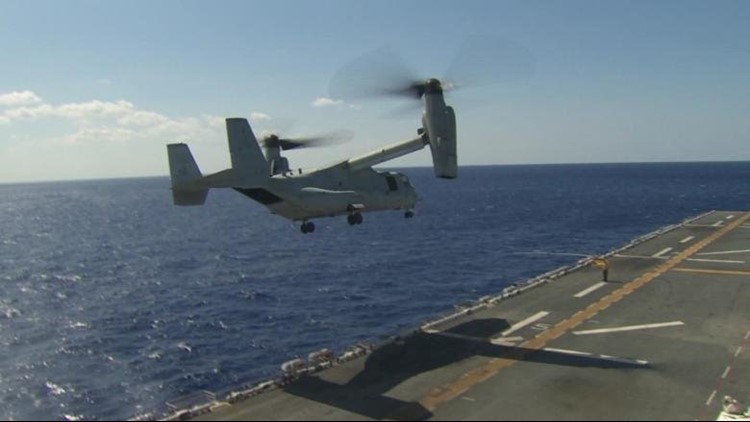Roaring off the deck of a 40,000-ton amphibious assault ship, F-35B fighter jets piloted by US Marines soar over the Pacific Ocean near the Japanese island of Okinawa.
It’s a show of force by the US military, which is demonstrating its newest — and most expensive — weaponry a week before it begins annual war games with South Korea.
The drills, which usually provoke fury from North Korea, will go ahead this year despite heightened sensitivity as diplomats try to organize a summit between the two Koreas, as well as an historic meeting between US President Donald Trump and the North Korean leader, Kim Jong Un.
The fifth-generation F-35B Lightning II jets — warplanes equipped with stealth technology to avoid radar and detection — have just started their first maritime deployment on board the USS Wasp, a warship sometimes dubbed a baby aircraft carrier that will take part in the joint exercises starting April 1.
The jets are seen as a major advantage for the United States in any contingencies involving North Korea as they are undetectable by Pyongyang’s radar although US government data released in January raised questions as to whether they were ready for combat.
The F-35B is one of three variants of the F-35 aircraft and the only one with the ability to land vertically like a helicopter. It can also takeoff in a much shorter space than other fighter jets, which is why it can operate off the Wasp, a warship only half the size of the 100,000-ton aircraft carriers in the US fleet.
“It really is an historic deployment, bringing this capability of the F-35 and the USS Wasp together to create the most significant increase in our capability the Navy and Marine Corps team has seen in our lifetime,” Rear Adm. Brad Cooper told CNN on board the Wasp.
Deficiencies?
With a projected price tag of a trillion dollars over the lifetime of the program, the F-35 fleet is the most expensive weapons system in history.
In a detailed report published in January by the Director, Operational Test and Evaluation (DOT&E), which reports to the Pentagon, experts found that as of October 2017, there were 263 high-priority performance deficiencies with the fleet.
Problems listed included flaws with the pilots’ night vision and delays in the supply of replacement parts.
The report concludes that the operational sustainability of the F-35 fleet is “below service expectations” and the unresolved issues “would not be acceptable in combat situations.”
Weapons acquisition expert Dan Grazier from the US nonprofit organization, Project on Government Oversight (POGO), says that any claims of the F-35’s combat readiness are “provably false.”
“They are just expensive prototypes,” says Grazier, who last week published an analysis of the Pentagon data on the F-35. “They haven’t even started the rigorous combat readiness testing which is a really important part of the program.”
However, Adm. Cooper insists those issues have been resolved.
“These F-35s are combat ready. If we needed to use them in combat today, they’re ready to go,” he said.
“These deficiencies for these aircraft that we have deployed out here have all been resolved, they’re full on and they’re ready to execute combat missions if called upon.”
F-35B pilot Capt. Robert Reddy, speaking in the hangar of the USS Wasp, said the new stealth is fighter is “very well thought out.”
“It’s a multi-role fighter. So its ability to fight air to air, air to ground and electronic warfare. It’s really quite special. All in one aircraft, all piloted by one person.”
The F-35 stealth fighters have been sold around the world to countries including the UK, Japan, and Israel.
South Korea has also ordered 40 F-35A stealth fighters, a move which has angered North Korea according to an article on state news agency KCNA published Sunday, which called it a “perilous move against the rare atmosphere of reconciliation.”
Drills
The Wasp, equipped with F-35Bs, will take part in the military drills with South Korea, which will go ahead with the same “scope and scale” as previous years’, Adm. Scott Swift, commander of the US Pacific Fleet, told CNN earlier this month.
But the two countries have made concessions towards the recent flurry of diplomacy, including delaying the drills until after the PyeongChang Winter Olympics and Paralympics in South Korea and shortening their duration.
The Foal Eagle and Key Resolve drills would begin on April 1 for four weeks, both countries said last week. Last year, Foal Eagle began on March 1 and continued until the end of April, lasting a total of two months.
The diplomatic developments of this year are a dramatic turnaround from the tense rhetoric and frequent North Korean missile launches which characterized 2017.
And although pursuing the path of diplomacy is the current course of action, out at sea, the US naval commanders are still preparing for any eventuality in case things don’t go as planned.
“For our enemies, these new capabilities simply make us more lethal,” Cooper says. “And we have the ability to bring a greater deal of lethality to the fight and ultimately win in combat.”



